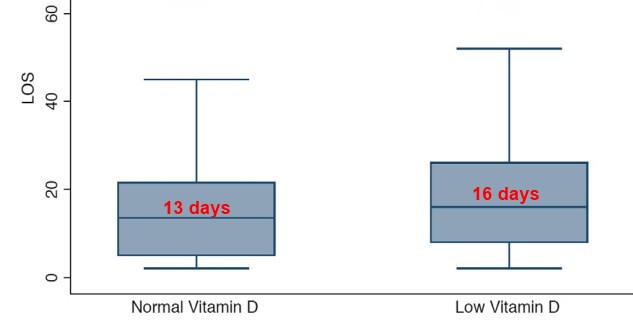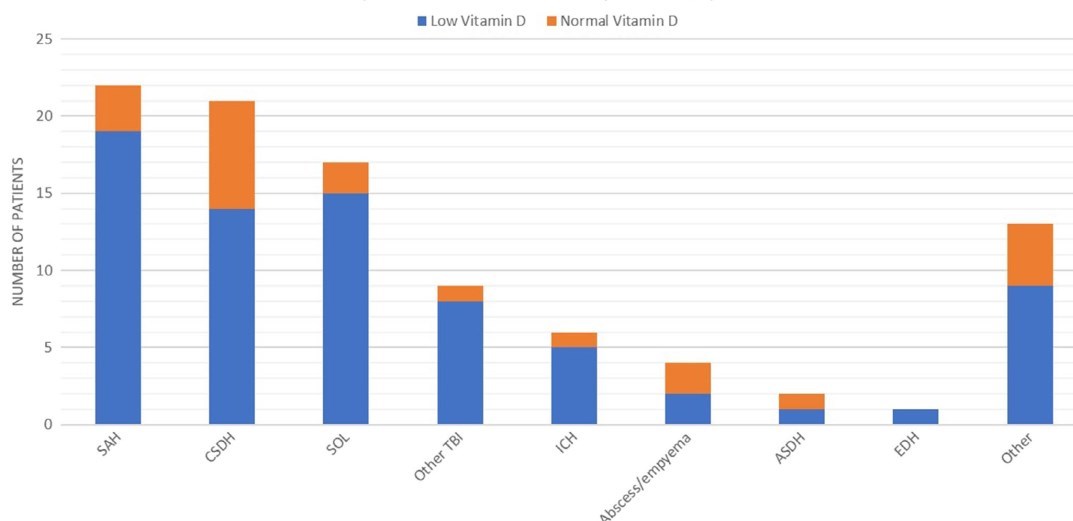3 additional hospital days after emergency neurosurgery if low vitamin D
Vitamin D deficiency is endemic in neurosurgical patients and is associated with a longer length of inpatient stay
Endocrinol Diab Metab. 2019;00:e00097. https://doi.org/10.1002/edm2.97
Ronak Ved | Peter Taylor | Philippa Stewart | Jonathan Foulkes | Wilem Fields- Jewell | Steve Davies | Caroline Hayhurst
📄 Download the PDF from VitaminDWiki

Introduction: Vitamin D deficiency is common in spinal surgery and critical care. Hypovitaminosis D may impact on outcomes in cranial neurosurgical care and play roles in underlying disease processes.
Methods: A prospective observational cohort study was performed. All emergency cranial neurosurgical ward admissions from 1st January to 10th May 2017 were screened for inclusion (n = 406). Patients already receiving vitamin D supplementation, spinal patients and elective admissions were excluded. Admission vitamin D levels were checked for all remaining patients (n = 95). Patients with vitamin D <30 nmol/L were defined as “deficient” and those 30-50 nmol/L as “inadequate.” All patients with levels <50 nmol/L were replaced, as per local guidelines. Descriptive analyses of the cohorts were undertaken, with multivariate regression used to assess the effect of vitamin D on length of stay, inpatient morbidity and mortality.
Results: The median age of participants was 61 years (n = 95; 57% male, 43% female). The median vitamin D level was 23 nmol/L (deficient). 84% (n = 80) of patients had low vitamin D levels, with 61% (n = 58) classed as deficient (<30 nmol/L). Vitamin D deficiency rates were similar in those aged below 65 years (86%; n = 38/44) and those above 65 years (82%; n = 42/51). Deficient vitamin D level was associated with longer hospital stay (P = .03), and this relationship persisted after adjusting for potential confounders such as age, sex and preadmission Charlson co-morbidity index. No statistically significant association was seen with vitamin D status and inpatient morbidity or mortality.
Conclusions: Vitamin D deficiency is common in cranial neurosurgical patients, even in predefined low-risk groups (age <65). Lower vitamin D level was associated with longer length of stay. This study supports the need for: (a) further investigation into the roles of vitamin D in neurosurgical pathologies and management and (b) an appropriately powered, randomised investigation into the impact of vitamin D status upon neurosurgical diagnoses and complications.
Surgery Type

SAH, Subarachnoid haemorrhage;
CSDH, Chronic subdural haematoma;
SOL, space occupying lesion;
TBI, traumatic brain injury
ICH, intracerebral haemorrhage;
ASDH, Acute subdural haematoma;
EDH, Extradural haematoma;
